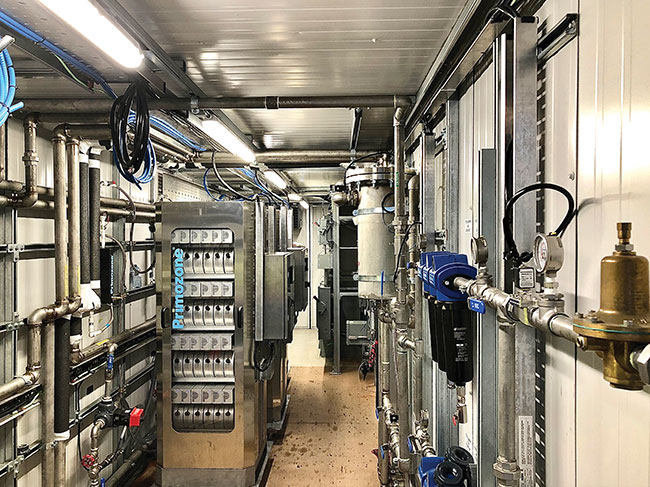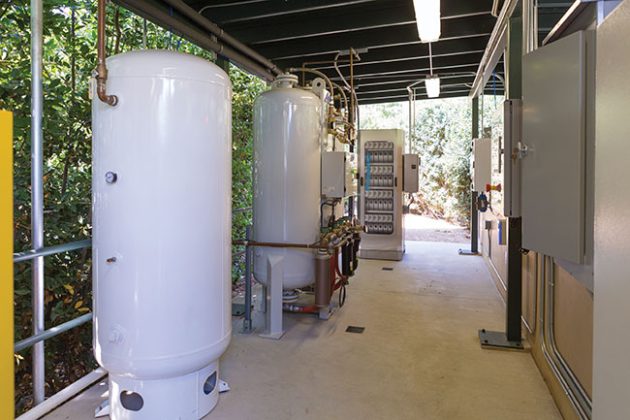
Features
Hatchery Operations
Systems management
Working with ozone
September 29, 2022 By Ron Hill
 Ozone system installed in Marystown, NL, Canada
PHOTO: VEK Environmental
Ozone system installed in Marystown, NL, Canada
PHOTO: VEK Environmental While there are many benefits to using ozone at a fish production facility, there can be resistance to consider adopting ozone disinfection. There are many misconceptions about ozone and ozone use, much of it based on lack of knowledge and a false sense that ozone is dangerous for staff to work with. Ozone is in fact, practical, economically viable and as safe or safer than chemical disinfection systems such as chlorine.
Ozone generators use oxygen (O2) to create ozone (O3). O3 is a powerful oxidizer that will oxidize any organics it comes in contact with, destroying them. This oxidizing potential makes ozone an effective disinfecting agent that destroys pathogens. Ozone is injected into aquaculture facility water destroying any organics it comes in contact with.
Because of the oxidizing power of ozone, systems must be robust and use quality. Stainless steel is highly recommended over plastic piping and fittings because of its high material resistance to oxidation. For the same reason, PTFE is highly recommended for gaskets.
Where to use
Ozone is most commonly used for two applications in aquaculture facilities: 1) disinfecting influent water for the facility from the water source, 2) in line water treatment as part of a recirculating aquaculture system (RAS) filtration setup.
Depending on a facility’s water source, ozone may be an effective choice to treat water as it is delivered to the facility. Many facilities that draw from water sources containing known pathogens will use ozone to annihilate all harmful microorganisms and break down organics in the water before it enters the facility. Surface water from lakes and rivers, as well as ocean-draw influent systems, often use ozone to create pathogen free water needed for aquaculture.
RAS can incorporate ozone disinfection into the filtration/disinfection system to provide effective pathogen removal. Ozone is injected into the water after solid removal and bio-filtration. After a brief contact time, the water is irradiated with UV light to remove the residual ozone. Following irradiation, the water is ozone free and ready to be oxygenated and sent to the fish tanks. Some operators will use low dosages of ozone to improve water quality and suppress background bacteria and rely on the other parts of their filtration/disinfection system to provide primary disinfection.
Redundancy
Choosing an ozone unit and system setup can be overwhelming to a facility operator. There are many companies and types/styles of ozone generators. Redundancy is one stressful “solution” operators have to weigh.
Because of the high cost of ozone systems and the relatively low amounts of maintenance, few facilities will choose a completely redundant system with a full backup. Larger companies tend to build in extra capacity or purchase oversized generators. Smaller companies tend to look for durable, fixable units with some extra capacity.
For any ozone application, essential spare parts, as laid out in the owner’s manual, should be on hand for maintenance staff.
“Companies looking for ozone units should always evaluate their CAPEX versus OPEX cost,” advised Chris Kinasewich, president of VEK Environmental and ozone system expert. “Cheap upfront units often come with expensive or difficult-to-get parts, which will need to be frequently replaced as routine maintenance. Some distributors and manufacturers provide no or very little support to the client. A reputable company with a good generator that requires little maintenance and offers support for the equipment can provide to a facility long term savings.”

VEK Environmental’s Primozone generators. PHOTO: VEK Environmental
Good oxygen for good ozone
The biggest key to operating and maintaining an ozone system is to keep the system from fouling. The unit will not foul on its own, the quality of the oxygen supply directly affects the unit’s ability to operate efficiently and continue to operate long term.
Oxygen can be generated on site from ambient air or be purchased as liquid oxygen (LOX). Aquaculture facilities are unique in that they already have a functioning oxygen system. This allows a facility to add capacity to their current oxygen system to be used for the ozone system or create a dedicated source of oxygen for ozone production. High quality gases for ozone units have two essential qualities (correct purity and correct dryness) measured as dew point.
“Ideal oxygen purity for ozone production is in the 93-96 per cent range which is the operating range for most oxygen concentrators,” says Kinasewich. “If the oxygen is too pure a nitrogen booster must be added to lower the purity.”
This is generally associated with using LOX as it comes with a purity of 98-99 per cent O2. Kinasewich warns, “Purity below 93 per cent puts the unit at risk of fouling and can cause issues with the dielectrics that will need to be cleaned, repaired, or replaced.”
Dew point is the temperature where a gas no longer holds water vapour and the moisture precipitates in the form of liquid water (condensation). In the case of an ozone plant, it indicates the temperature where water will come out of the gas and condensate inside the ozone generator. Low dew point values indicate dry. Ozone manufacturers request that feed oxygen supply have a dew point below -60 C. If the dew point rises, this indicate the oxygen coming into the ozone generator isn’t being properly dried or there is contamination from outside gases.
“Water vapour forms a water layer on top of the dielectric surfaces increasing surface conductivity which will lower ozone production,” advises Kinasewich. “Water within the ozone unit turns into sticky brown nitric acid which creates a film that can clog discharge gaps. Nitric acid can corrode the inside of the unit and lead to dangerous arcing that can blow protective fuses and cause dialectic failure.”
Ozone systems should have an automated shutoff attached to the dew point sensor to shut down the ozone generator if dew point rises to a certain threshold.
Managing and monitoring
Comprehensive automated controls and sensors systems are available to automate and integrate the ozone system into the facility’s centralized monitoring and control platform. A facility’s choice of ozone monitoring and control will depend on individual need and available budget. The greater the budget the more bells and whistles available.
Dew point, incoming oxygen purity, oxygen flow and ORP are essential monitoring/alarm points. For human safety, ambient ozone alarms connected to a central alarm system are required. If ozone is detected the first alarm will trigger. The second alarm will trigger if ambient ozone approaches unsafe levels, also causing the ozone generator to shut down and the flow of ozone to cease.
Effectiveness of an ozone unit is measured through oxidation-reduction potential (ORP) sensors. ORP is a measurement that indicates the degree to which a substance is capable of oxidizing or reducing another substance. Ideal ORP for most ozone units in freshwater is -350mV, though facilities will choose based on their needs and water quality.
“Changes in ORP indicates one of two things,” Kinasewich asserts. “Changes in the contents or quality of the water or issues with the ozone unit itself causing ozone production to drop.”
Influent systems drawing and disinfecting surface water that may have changing conditions are wise to consider automated control of the ozone unit through ORP. Events like storms and lake turnover can put heavy amounts of sediment and organics into the water column. This extra organic material can overwhelm current ozone production. Sensors detect the decrease in ORP, and automated controls can increase ozone production to maintain effective dosage for disinfection.
Maintenance
Ozone units do not require a lot of scheduled maintenance. There is a huge variety of ozone units on the market and the owner’s manual and the distributor/manufacturer should provide a comprehensive maintenance schedule. Units can run for many years without a decrease in effectiveness as long as the unit is properly cared for.
“I cannot understate the importance of maintaining the oxygen supply, specifically the oxygen concentrator and air compressor. Maintaining a supply of high-quality oxygen through scheduled routine maintenance of the generation system is one of the best ways to maintain the ozone unit,” stressed Kinasewich.
Issues with ozone generators usually show themselves through reduced effectiveness or a loss of production capacity. This typically leads to cleaning or repairing the ozone generators. Depending on the make or model of the ozone generators, this could range from an easy fix to an extensive service repair which then leads to a complete shut down of the ozone system.
Shutdowns can be problematic for many operations as there are fish in the system that must be maintained. Some systems do not have a shutdown period, movement options aren’t always available, and the operator must risk operating without the ozone system for a time. Downtime and fish juggling increase the cost of maintenance quickly. Facility staff may or may not be able to perform the disassembling and maintenance, adding an expensive service call (and all the associated delays) to the problem.
A safe choice
The ozone industry has worked hard to promote awareness and increase both safety and knowledge.
“The industry has done and exceptional job educating manufacturers and sales representative on ozone safety. Very good safety standards have been developed and are provided to customers,” Kinasewich commented on ozone safety.
“Safety is driven by education. Taking the time to train staff about operations and safety is the best way to promote safe operations. Technicians that understand the technology from the outset will become experts with the unit, can educate other staff and will properly maintain their system.”
Distributors and manufacturers provide safety technology options and work with the facility safety group to develop a safe operation plan. Training and hand-off services include seminars to get employees who will be working with the ozone system comfortable operating the equipment.
The International Ozone Association (IOA) is a not-for-profit educational association that shares information about ozone equipment, operations and safety and has been a key player developing standards for ozone. The IOA provides excellent resources for ozone operators including safety sessions and technology webinars to educate and promote ozone (www.ioa-pag.org).
Print this page





